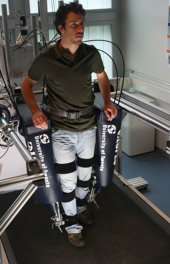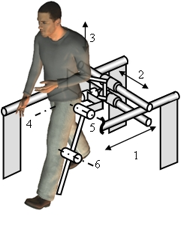Subject’s leg strapped to LOPES exoskeleton
(Medical Xpress) -- When it comes to recovering from a stroke, one of the major goals or rehabilitation is learning how to walk again. Researchers in the Netherlands are working with a prototype device called the LOwer Extremity Powered ExoSkeleton, or LOPES, to help retrain the mind and body of stroke patients and help them regain the ability to walk with a natural step.
Researchers from the University of Twente have been developing LOPES over the last several years. It is designed for rehabilitation clinics as a support for patients on a treadmill. The machine is able to do all of the walking for a patient, offer support to one leg or the other and can detect what the patient is doing wrong with their walking.
For example, the machine compares how the patient is lifting their foot to a reference pattern. If the patient is not lifting the foot correctly, the machine will exert force or torque in order to help the patient perform the action correctly.
Schematic overview of degrees of freedom
While aiding the patient in the physical mechanics of moving their legs, the machine also works as a memory aid. The feeling of correct movement has triggered memories in the brain of how walking should occur. The researchers believe that by physically making them perform the movement correctly, the action helps the brain develop the signals required for eventual movement on their own.
LOPES is also being used with spinal injury patients that still have some function in their legs or have recovered some limited use. The researchers hope to have a commercial version of LOPES available to rehabilitation clinics around the world sometime in the next year.
More information: Project page
via BBC
© 2011 PhysOrg.com




















